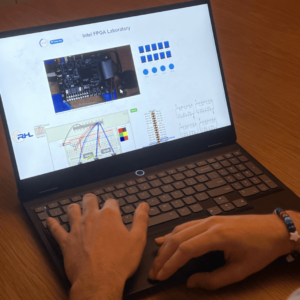 Authors:
Authors:
- Pedro Amarante, he/him, undergraduate student, Electrical & Computer Engineering, University of Washington, Seattle campus
- Rania Hussein, she/her, Associate Teaching Professor, Electrical & Computer Engineering, University of Washington, Seattle campus
Project Description
The RHL-Butterfly project offers a virtualized breadboard solution for FPGA and ARM microcontroller experimentation in remote laboratories. Instead of the student physically using the hardware, we provide a remote option, which includes simulation of specific devices. This project addresses the need for hands-on engineering labs in online education. By combining virtual and physical elements, it ensures creative and effective learning experiences, simulating real-world industrial hardware development and fostering practical skills in circuit design and digital logic.
Project Question
The project seeks to address the challenge of providing effective, hands-on laboratory experiences in embedded systems education during remote learning scenarios. It aims to overcome the limitations of traditional laboratory setups by developing a virtualized breadboard solution that maintains the integrity of real-time embedded systems.
Context
The project is used in EE/CSE 371, which is a class that has around 80 students per quarter. It’s a class jointly offered for ECE and CSE majors, and it is required for Computer Engineers, and an elective for Electrical Engineers and Computer Science Majors, it is offered in person.
Methods
The project is going to answer the questions by analyzing user feedback, performance in relevant courses, and comparisons with traditional laboratory methods. Students were asked to participate in an anonymous online survey indicating the usability and practicality of the virtualized breadboard based on a 5-point Likert scale
Impact/Assessment
The project enhances student learning in embedded systems by providing a practical, remote laboratory experience. It allows students to experiment with designs and understand theoretical concepts without the limitations of physical hardware. Thus far, the study scored results favoring the virtualized breadboard. With this research supporting virtual breadboard solutions for engineering curriculum, we have confidence that this scaled virtual solution brings effectiveness to laboratory learning, and to curriculum beyond Design of Digital Circuits
Application
The project highlights the potential for virtual laboratories to provide effective and accessible learning experiences. Other instructors might be inspired by our project to implement and experiment with virtual hardware. The whole of the project is made to be adaptable to other institutions/classes. It provides powerful insight on how students are impacted by technology.